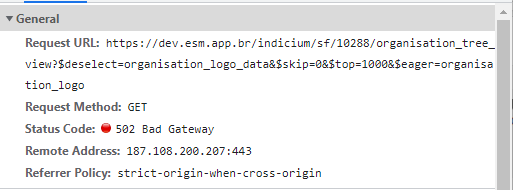Any indications what's the issue here? With getting the logo_data for a tree view I get a bad gateway (502) error..

followed by a similar request that gives a 200 OK.

Any indications what's the issue here? With getting the logo_data for a tree view I get a bad gateway (502) error..

followed by a similar request that gives a 200 OK.

Best answer by Vincent Doppenberg
Hello Freddy,
The default request timeout on IIS is 110 seconds. We don’t really have a recommendation for this, because it depends on the application. But 110 seconds rarely leads to problems so that seems like a good value to suggest for now.
As for the proxy buffer sizes, I don’t have any suggestions for this without looking into it more. However, I would imagine that the default settings of nginx are good. This is not something that I would expect to need additional configuration.
Enter your E-mail address. We'll send you an e-mail with instructions to reset your password.